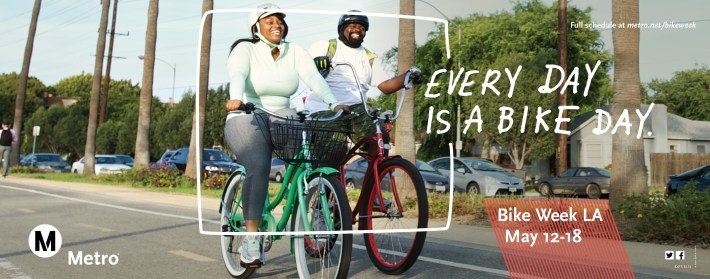Showdown Over Bike/Walk Funds Missing from Metro Short Range Plan
4:44 PM PDT on July 14, 2014

Metro's Short Term Transportation Plan is on the agenda for this Wednesday's Metro board Planning and Programming Committee. The SRTP is the agency's $88 billion plan for the next 10 years.
Though concerns have been raised about technology, articulated buses, and extending the Gold Line east of Azusa, the main point of contention appears to be over funding for active transportation: walking and bicycling. Overall, the 10-year plan includes $500 million worth of active transportation funding, just 0.6 percent of the overall $88 billion budget.
The Safe Routes To School National Partnership (SRTS) and the Los Angeles County Bicycle Coalition (LACBC) have been at the forefront of a broad coalition urging greater Metro investment in active transportation. They are mobilizing organizations and individuals to attend the Metro committee meeting on Wednesday, July 16 at 2:30 p.m.
From the SRTS website:
In Metro’s view, walking and biking are the purview of cities, not a regional transportation priority. As a result, Metro has a fragmented approach to walking and biking that does not ensure that all of the parts add up to a region that is in fact multimodal, safe and serves the needs of all travelers and all trips. [...] As Metro prepares for a possible new transportation sales tax in 2016, now is a critical time to reevaluate the region’s policy vision and investment strategy to support a transportation system that works for all.
More than 60 organizations signed on to this L.A. County Active Transportation Collaborative comment letter. Other non-profits urging greater funding for walking and bicycling include NRDC-Climate Plan-Coalition for Clean Air, Move L.A., and the Sierra Club Angeles Chapter Transportation Committee.
It's not only non-profit community organizations echoing the call to support walking and bicycling. Also submitting comments to Metro were the L.A. County Department of Public Health, the L.A. Unified School District, and Jon Kirk Mukri's city of Los Angeles Department of Transportation (LADOT.) Here is an excerpt from LADOT's refreshingly livability-minded comment letter:
The allocation of future funding should be better aligned with City, County and State goals and policies relative to complete streets, sustainability, first/last mile solutions and active transportation. The SRTP should provide more insight on how investments for multi-modal transportation solutions can be better defined in Metro’s future funding strategies. [...] [F]unding programs should encourage projects that connect more people to existing and future stations through first/last mile bicycle and pedestrian connections and LADOT DASH shuttle bus routes. Of all the trips made in the City of Los Angeles, almost 50% are less than three miles in length, yet approximately 85% of these trips are made by car. Focusing more future funding on active transportation connections and local circulators can significantly reduce congestion, reduce greenhouse gas emissions and have the added benefit of expanding the reach of the public transit system.
Metro staff's response to SRTS call for active transportation funding has been to downplay active transportation statistics. Metro cites only 5 percent of commute trips via walk and bike, compared to an all-trip figure of 20 percent; either way the 0.6 percent of funding remains at least an order of magnitude less than the percentage of trips. Despite upward trends locally and statewide, Metro discounts L.A. County travel survey data (which generally under-counts non-car-commutes) as "a very general description of existing use, not future needs." The staff report further paints walking and bicycling as "local" and "recreational" hence not "regionally significant" enough to be funded by Metro. Staff also cite the Metro Call for Projects as way the agency "encourages" first/last mile connections, despite shrinking federal dollars causing the Metro Call to shrink and back track.
With Metro's recent approval of its First/Last Mile Strategic Plan, the agency appeared to acknowledge and embrace its role in supporting the roughly 90 percent of its transit customers who begin their trip on foot and by bike (per Metro's own on-board survey data.) On Wednesday, Metro's Planning Committee has a chance to re-align the agency's spending priorities in support of safe and convenient walking and bicycling.After the SRTP is heard in committee this week, it will likely move on to be heard by the full Metro Board of Directors at its meeting next week on Thursday, July 24.
Stay in touch
Sign up for our free newsletter
More from Streetsblog Los Angeles
Metro Board Funds Free Student Transit Pass Program through July 2025
Metro student free passes funded another year - plus other updates from today's Metro board meeting
Eyes on the Street: New Lincoln Park Avenue Bike Lanes
The recently installed 1.25-mile long bikeway spans Lincoln Park Avenue, Flora Avenue, and Sierra Street - it's arguably the first new bike facility of the Measure HLA era




